yogabook / asanas / chakrasana
Contents
chakrasana
„wheel“
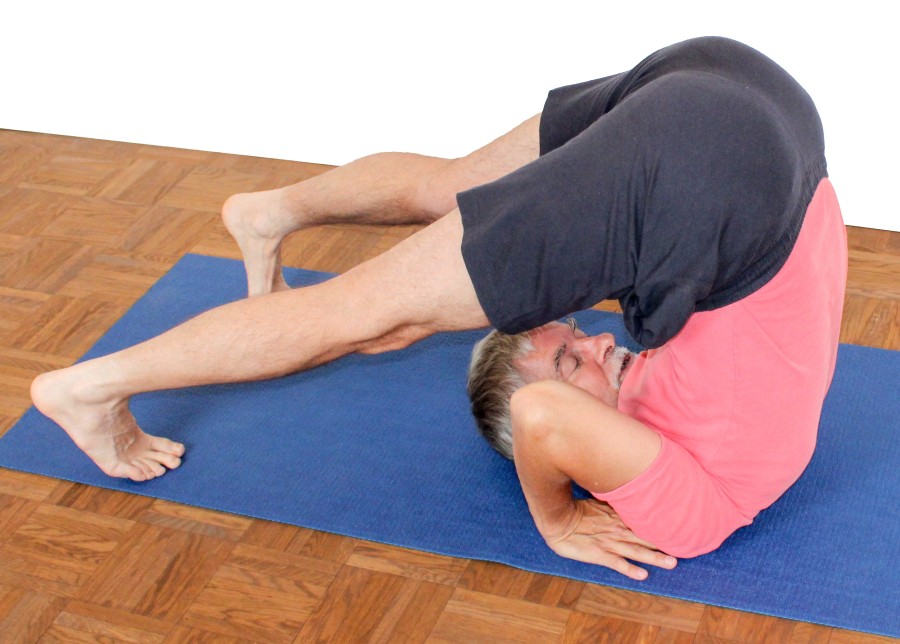
 instructions and details with working links as PDF for download/print
instructions and details with working links as PDF for download/print
Detailfotos
from karnapidasana .. | .. place the hands..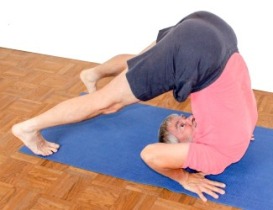 | .. discharge the head .. | ..lift it from the floor..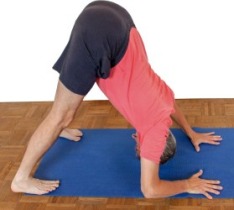 | ..stretch your arms |
Feedback: We’d love to hear what you think about this description, give us feedback at:
postmeister@yogabook.org
Last modified: 30.12.2018
Name: chakrasana
Trivial name: wheel
Level: A
- classification
- contraindications
- effects
- preparation
- follow-up
- derived asanas
- similar asanas
- diagnostics
- instructions
- details
- variants
Classification
classic: powerful transition
psychomental:
physiological:
Contraindication
Poses and movements that convexly round (flex) the spine are contraindicated in the case of acute disc hernia in the lumbar spine and can cause pain and have a detrimental effect on the relief of symptoms; the same applies to the cervical spine.
Effects
Preparation
You need very good flexibility in the back, in particular the cervical und upper thoracic spine, so that this rolling action can be successful and the flexion remain tolerable for the cervical spine. This must be prepared:
The general flexibility of the back, including parts other than the cervical spine, also plays a role and can be prepared with:
Shoulder strength:
- dips variant of downface dog
- the transition from downface dog to upface dog and back
- the transition from downface dog to staff pose and back
- dips variant of the handstand
- repeatedly entering and exiting the back arch (back arch dips)
In the phase when the shoulder area has already lifted off the floor, the demand on the flexibility in the hamstrings increases, so it makes sense to prepare it:
- uttanasana
- parsvottanasana
- head down dog
- hip opener 5
- warrior 3 pose
- trikonasana
- parivrtta trikonasana
- parivrtta ardha chandrasana
- supta krouncasana
- krouncasana
Follow-up
Derived asanas:
Similar asanas:
Diagnostics (No.)
(650) In karnapidasana and during rolling, abnormalities in the shape of the spine become clearly visible:
Deviations from the regular total flexion of the human spine become quite visible in this pose. A lordosis remaining in the lumbar spine can be an indication of a hollow back and shortened hip flexors, see the FAQ. From the lower lumbar spine onwards, the spinous processes of the vertebrae should progressively and evenly move outwards, reaching a maximum in the lower thoracic spine, which is roughly maintained.
(611) In karnapidasana and during rolling, scolioses become clearly visible:
the lateral deviation of the spine in the frontal plane from the median plane, known as scoliosis, is also quite visible in this pose. See the FAQ.
(673) The rectus abdominis muscle:
In this pose, the rectus abdominis can cramp because it tries to perform the flexion of the upper body so that the muscles actually performing the pose/movement have to work less intensively. On the one hand, this can be a statement about increased tension – and possibly not particularly great strength – in the abdominal muscles, on the other hand it may be a statement about the muscles performing the movement.
Variants:
Instructions
- Take karnapidasana. It is best to practise with your shoulders on a mat folded in half twice, but do not place your head on the mat so that it is lower.
- Allow a little time for the back muscles to become more flexible.
- Move your feet as far back from your shoulders as possible and straighten your legs.
- Place your hands on the floor so that your fingertips are approximately under your shoulders and your fingers are pointing towards your feet.
- Shift as much weight as possible onto the feet and increase the strength in the arms so that the shoulders lift up and the body can roll over the back of the head.
- Straighten your arms and come into a full downface dog.
Details
- Performing chakrasana requires a greater degree of flexibility in the cervical spine and thoracic spine as well as a greater degree of strength in the deltoids and triceps. As a result, chakrasana is not suitable for beginners. Even more advanced performers have to take restrictions and discomfort in the neck into account and will therefore often refrain from practising chakrasana.
- Do not use momentum to lift the upper body off the floor. Using momentum harbours the risk of uncontrollably bending the cervical spine beyond its tolerance. The movement of the upper body must result from building strength without momentum, otherwise chakrasana should be avoided and flexibility-enhancing (cervical spine, thoracic spine) or strengthening (shoulder, triceps) preliminary exercises should be practised instead. The pressure on the feet from working the arms must become stronger and stronger. It must be present to a minimum extent at the beginning of the transition.
- Chakrasana is not recommended for those with so limited a flexibility of the back that the feet in karnapidasana or halasana cannot reach the floor or only with difficulty. The same applies to those whose arm strength is insufficient to perform the staff pose. A further requirement is the flexibility of the shoulder joint in the direction of frontal adduction with simultaneous strong external rotation of the arm. Anyone whose (sagittal) angle between the upper body and upper arm in dog elbow pose does not significantly exceed approx. 160° should also refrain from chakrasana.
- For assistance, a second person can stand behind the legs and pull them towards you close to the pelvis, see below. If it becomes apparent that the performer’s strength or flexibility is insufficient, they must be released slowly and carefully.
- The knees should remain straight during the transition, so do not put your knees down in between and then straighten your legs again. Bending the knee joints a little would make it somewhat easier to stretch the back by relieving the hamstrings, but further bending would tend to curve the back due to the pull of the short hip extensors. Practice shows that, beyond this movement-physiological logic, stretching the legs tends to be associated with stretching the back with average body awareness.
- Always keep your elbows as tight as possible during the transition. As soon as the transition regularly works, include this detail; however, at the beginning of practising chakrasana, the elbows will probably move outwards uncontrollably.
- With sufficient strength and flexibility, the transition can be performed as slowly and reversibly as you like. However, the transition back into karnapidasana should only be practised if the transition from karnapidasana into downface dog is successful and not if it is only borderline successful.
- The fingertips should be positioned approximately under the shoulders. If the hands are too far away from the shoulders, the angle of dorsiflexion in the wrists will be too unfavourable and the large amount of strength required may be limited by the discomfort.
- Of course, chakrasana can also be practised from karnapidasana with support under the shoulders.
- Limited flexibility of the short/monoarticular hip extensors (especially the gluteus maximus) can also restrict the execution, as the gravity perpendicular does not become favourable enough to initiate the transition without swinging and endangering the cervical spine. The same applies to the hamstrings, as a reduced extension of the legs also results in a less favourable gravity perpendicular because the pelvis is tilted more against the vertical and as a result more upper body mass lies beyond the hands.
- The demands of chakrasana can be reduced slightly by placing the shoulders (but not the head) on an elevation. This offers a threefold simplification:
- the cervical spine is significantly relieved because the necessary flexion is reduced
- as the hands are positioned lower than the shoulders, the extremely unfavourable flexion angle in the elbow joints at the start of the transition is slightly more favourable, which enlarges the possible force the triceps can exert and also that of the deltoid, as its sarcomere length is more favourable.
- the body’s centre of gravity is already slightly higher than without support under the shoulders, which means that the potential energy to be supplied is slightly lower, meaning that slightly less strength is required in the deltoids and triceps in order to take downface dog from karnapidasana.
It is also often possible to position the 7th cervical vertebra right next to the support so that the pressure on it, which is often perceived as uncomfortable, does not occur. However, this support can also have a small disadvantage: the position of the hands should normally be such that the fingertips are just below the shoulders, which requires good flexibility of the shoulders and the widest possible flexion of the elbows. With shoulder-width support under the shoulders, it is not possible to position the hands identically, as the support is now located where the fingertips should be; when trying to move the fingers as close to the shoulders as possible, the fingertips hit the support first. This means that the pelvis has to be pushed a little further towards the feet to initiate the transition, which would typically require more flexibility in the upper thoracic spine. However, as this requirement has been reduced by the support, this does not hinder the execution. Nevertheless, the use of arm strength is slightly more difficult: the further the wrists are positioned away from the shoulders, the later in the transition the arms push the upper body towards the feet – instead of in the opposite direction. The ability to push the pelvis more towards the feet gained through the support must therefore be fully utilised for the transition to be successful. This disadvantage of the support can be avoided if the support is sufficiently narrow, i.e. does not support the acromion area of the shoulders (which strictly has to be supported in shoulder stand, for example), but only approx. 15 cm around the spine, which is usually sufficient. This can be achieved with a shoulder stand plate under the spine that is not too wide and leaves the acromion on both sides free. See the corresponding variant.
- As described above, the transition should be performed without momentum, as slowly and reversibly as possible, so that the cervical spine cannot be damaged. We are familiar with the tendency to replace a lack of strength with momentum from a number of other transitions. This raises the question of how strong the deltoids (pars clavicularis and pars acromialis) and the triceps need to be for the transition to be successful and what the suitable preliminary exercises are. A good reference is the transition from the downface dog to staff pose and, above all, back to downface dog. Physiologically, a muscle has significantly more strength in eccentric contraction than in concentric contraction (force-velocity-function according to Hill/Herzog). In addition to the loss of potential energy during the transition into the staff pose, the reason for this is that this transition into the staff pose is significantly easier than the reverse path back into downface dog. If this is also successful, you should have enough strength to perform chakrasana. The transitions are not exactly comparable, as the distance between the feet and the hands in downface dog after chakrasana is likely to be significantly smaller than the usually slightly larger distance chosen for the transition between downface dog and staff pose, which leads to a sharper flexion and more potential energy of the body after chakrasana. Accordingly, the stretching arms in chakrasana are steeper towards the floor, which also indicates a greater force to be exerted. Nevertheless, this is probably still the best criterion and one of the best preliminary exercises.
- The „back arch dips“ are an excellent pre-exercise due to the very similar type and extent of movement and exertion.
Known problems that can occur even when performed correctly
Neck
Depending on your constitution, daily form and warm-up, a feeling of pressure in the area of the 7th cervical vertebra or a mostly moderate discomfort in the muscles of the cervical spine may remain after the pose. Both can last until the next day under certain circumstances.
Variants
on elevation on a shoulder stand plate

Instructions
- Set up karnapidasana so that the spine lies on an elevation that leaves the area of the acromii free, e.g. a shoulder stand plate aligned lengthways.
- For chakrasana, place the fingertips on the floor next to the elevation, well below the arcomii to perform the transition to downface dog.
Details
- This variation provides relief in several ways:
- as the shoulder area is higher, less work is required for the transition
- the most important muscles involved, the triceps and deltoids, which have to perform heavy concentric contractions, start at a slightly more favourable sarcomere length
- The flexion of the cervical spine is less at the beginning and will have to be less pronounced throughout the transition than without elevation
(P)
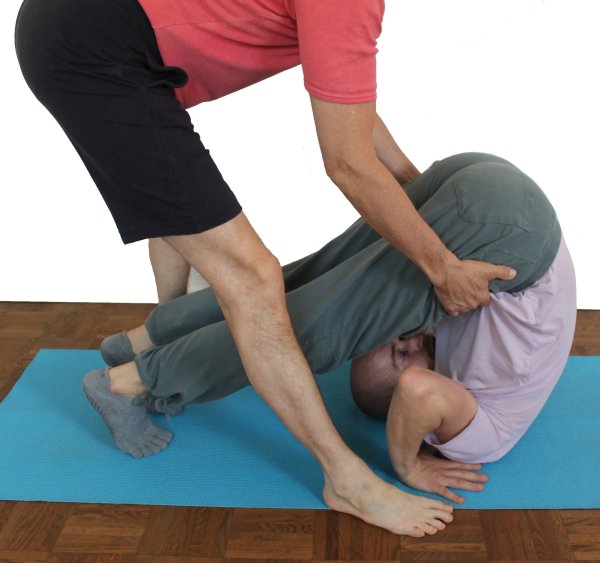
detailed photos
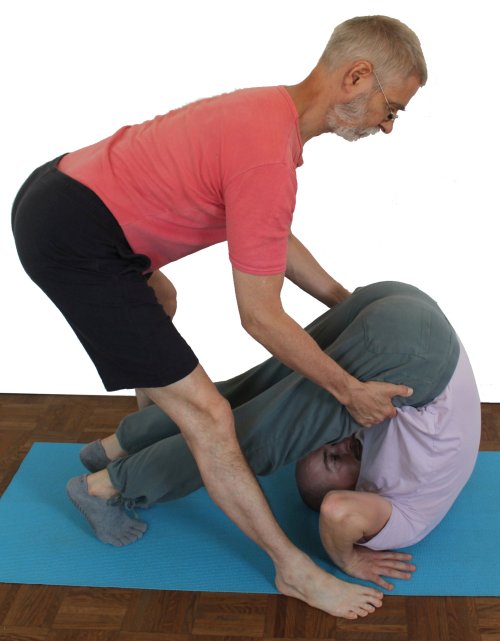 | 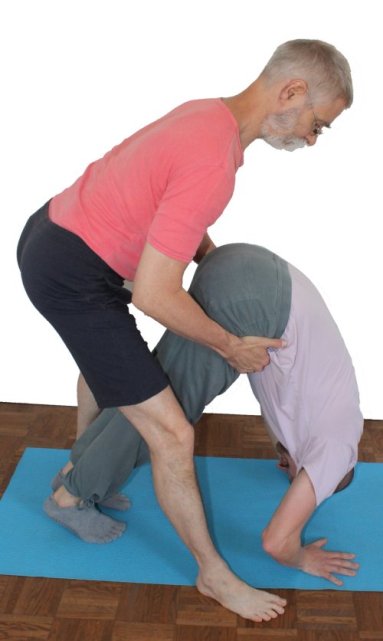 |
| Tests, ob HWS den genügend beugt | ziehe nur nach Bedarf |
Instructions
- The supporter stands firm in a moderate straddel behind the feet of the performer and carefully pulls the performer into downface dog, paying attention to the condition of the performer’s neck.
Details
- As described above, the sensitivity of the neck determines whether the transition can be practised without support. Of course, this also applies with support, but the supporter does not have the proprioception of the performer and therefore must rely on his feedback.
- The pull on the thighs does not go exactly vertically upwards but upwards and backwards.
- The support is particularly useful if the performer’s shoulder (deltoid) and triceps strength is insufficient. If the neck or upper thoracic spine is too stiff, care must be taken not to overstrain them and the attempt may have to be aborted! The demand on the flexibility of the cervical spine is reduced in the variant with elevation of the shoulder area.
- The supporter only helps as little as necessary and only where and for as long as necessary. The aim is to make the transition under your own power and to be clear about the movements to be performed and the forces to be applied.
Transition to the staff pose

Instruction
- Take karnapidasana. It is best to practise with your shoulders on a mat folded in half twice, but do not place your head on the mat so that it is lower. Position yourself so far back on the mat that your feet are not on the mat later on.
- Give yourself a little time until your back muscles have become more flexible.
- Push your feet as far back from your shoulders as possible and straighten your legs.
- Place your hands on the floor so that your fingertips are roughly under your shoulders and your fingers are pointing towards your feet.
- Shift as much weight as possible onto your feet and increase the force exerted by your arms so that your shoulders lift up and your body can roll over the back of your head.
- Straighten your arms, stretch your hips, allow your feet to slide further back and push yourself into the staff pose.
Details
- ..
